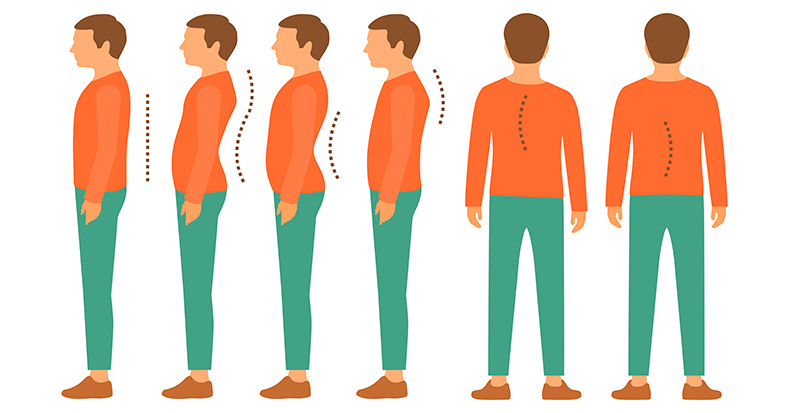
Exercises for Improving Cervical Posture
- Crystal -
- September 09, 2019 -
- Blog
Click edit button to change this text. Lorem ipsum dolor sit amet, consectetur adipiscing elit. Ut elit tellus, luctus nec ullamcorper mattis, pulvinar dapibus leo.
Is there a “normal” or “best posture” out there? If so, what is it?
Posture is largely inherited; however, there are also environmental, social, and other forces that can affect posture. Some say “good posture” is the position that places the least amount of strain on the body, particularly the muscles and ligaments that hold the body together.
A common cause of poor posture is called forward head carriage (FHC), where the head sits forward of the shoulders, placing a greater strain on the back of the neck and upper back to hold the head upright. Looking at the spine from the side, the opening of the ear should line up with the shoulder, hip, and ankle.
There have been studies that suggest every inch (2.54 cm) of FHC increases muscle strain in neck and upper back by 10 pounds (4.5 kg). That means a 5 inch (~12.7 cm) FHC adds an extra 50 pounds (~22.7 kg) of strain on the neck and upper back to hold the head upright. So what can we do to improve our posture?
First, stay active to reduce the normal rate of degeneration that affects us all as we “mature” through life! This recommendation requires us to keep fit and strive to maintain a normal BMI (“body mass index” or weight/height ratio) by balancing calorie intake and exercise.
Now, besides being evaluated for specific spinal care, there are a couple exercises you can do to help improve your cervical posture:
EXERCISE #1 is called a chin tuck. Here, you simply pull your chin inwards, producing a “double chin.” If you do this as far as you can and talk your voice will sound funny (“nasal-like”). Release the tuck until your voice clears. The moment it clears, STOP – that’s your “new” head position. Try to maintain that all day. You will have to remind yourself to “…keep it tucked” frequently at first but as time goes on, it will feel more natural. This can take about three months on average, so BE PATIENT!
EXERCISE #2 will strengthen the deep neck flexor muscles by doing the exact same thing as exercise #1 BUT adds a hand, a towel, or a TheraBand (anything works) for resistance behind the neck so that as you chin tuck, you PRESS the back of your mid-neck into your finger tips (or Band, towel, etc.) and hold for five seconds (then, release slowly). Do this five, ten, or multiple times a day.
There are other exercises but this is a GREAT start! See your doctor of chiropractic for more specific individual needs!
We realize you have a choice in whom you consider for your health care provision and we sincerely appreciate your trust in choosing our service for those needs. If you, a friend, or family member requires care for neck pain or headaches, we would be honored to render our services.
Is there a “normal” or “best posture” out there? If so, what is it?
Posture is largely inherited; however, there are also environmental, social, and other forces that can affect posture. Some say “good posture” is the position that places the least amount of strain on the body, particularly the muscles and ligaments that hold the body together.
A common cause of poor posture is called forward head carriage (FHC), where the head sits forward of the shoulders, placing a greater strain on the back of the neck and upper back to hold the head upright. Looking at the spine from the side, the opening of the ear should line up with the shoulder, hip, and ankle.
There have been studies that suggest every inch (2.54 cm) of FHC increases muscle strain in neck and upper back by 10 pounds (4.5 kg). That means a 5 inch (~12.7 cm) FHC adds an extra 50 pounds (~22.7 kg) of strain on the neck and upper back to hold the head upright. So what can we do to improve our posture?
First, stay active to reduce the normal rate of degeneration that affects us all as we “mature” through life! This recommendation requires us to keep fit and strive to maintain a normal BMI (“body mass index” or weight/height ratio) by balancing calorie intake and exercise.
Now, besides being evaluated for specific spinal care, there are a couple exercises you can do to help improve your cervical posture:
EXERCISE #1 is called a chin tuck. Here, you simply pull your chin inwards, producing a “double chin.” If you do this as far as you can and talk your voice will sound funny (“nasal-like”). Release the tuck until your voice clears. The moment it clears, STOP – that’s your “new” head position. Try to maintain that all day. You will have to remind yourself to “…keep it tucked” frequently at first but as time goes on, it will feel more natural. This can take about three months on average, so BE PATIENT!
EXERCISE #2 will strengthen the deep neck flexor muscles by doing the exact same thing as exercise #1 BUT adds a hand, a towel, or a TheraBand (anything works) for resistance behind the neck so that as you chin tuck, you PRESS the back of your mid-neck into your finger tips (or Band, towel, etc.) and hold for five seconds (then, release slowly). Do this five, ten, or multiple times a day.
There are other exercises but this is a GREAT start! See your doctor of chiropractic for more specific individual needs!
We realize you have a choice in whom you consider for your health care provision and we sincerely appreciate your trust in choosing our service for those needs. If you, a friend, or family member requires care for neck pain or headaches, we would be honored to render our services.
- YOU MIGHT ALSO LIKE

Tension vs. Migraine – What’s The Difference?
November 11, 2019
The Heat is on for This Natural Back Pain Relief
December 12, 2016

Why Chiropractic is a Good Idea
December 14, 2017